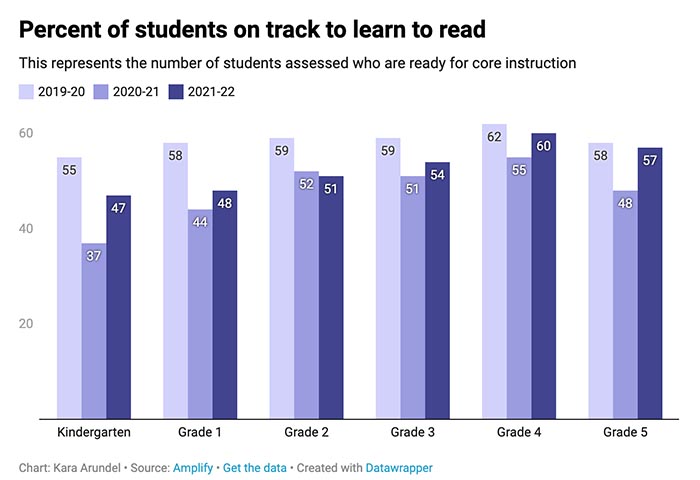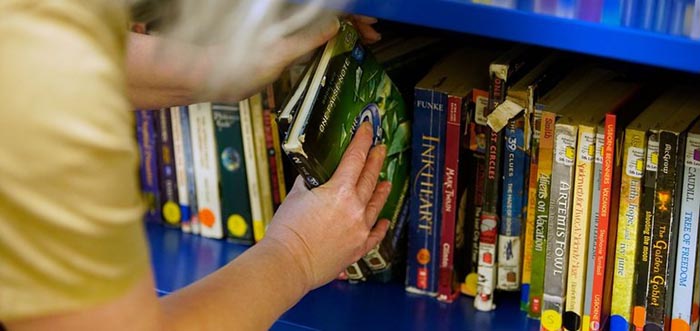
Results from the assessment show stagnant progress of 2nd graders this school year compared to last.
From K-12 Dive
By Kara Arundel
Feb. 23, 2022
More young elementary students are at-risk of falling behind in learning to read than two years ago, according to a report from Amplify that analyzed performance results from the Dynamic Indicators of Basic Early Literacy Skills assessment.
The 2021-22 mid-school year assessment results show 47% of kindergartners and 48% of 1st graders were ready for core instruction in early literacy skills results, down from 55% of kindergartners and 58% of 1st graders in 2019-20. Amplify, a curriculum and assessment company that uses its mCLASS platform to help teachers administer the DIBELS, compared data across three school years: 2019-20, 2020-21 and 2021-22.
In response to concerns that the youngest students had low enrollment rates during the pandemic and may have missed foundational reading instruction during building closures, school systems are using a variety of interventions, such as intensive tutoring programs, changing core instruction, and implementing multi-tiered systems of support to help students build literacy skills.
Helping struggling readers reach grade-level standards is critical, said Susan Lambert, Amplify’s chief academic officer of elementary humanities.
“School moves on whether they learn how to read or not, and we need to teach them to employ and get really good at — automatically get good at — these reading skills in the early grades,” Lambert said. “If we don’t do that, they’re going to learn strategies that are actually connected with poor reading skills.”
Disproportionate impact
The pandemic disproportionally affected the percentage of Black and Hispanic students who were ready for core instruction in early literacy, the report found. For instance, 57% of White kindergartners are on track to learn to read this school year, compared to 42% of Black students and 40% of Hispanic students.
While disparities in reading readiness existed before the pandemic, the gaps are now greater.
Additionally, the DIBELS data shows Black and Hispanic kindergartners are in greater need of intensive reading interventions this school year, compared to White kindergartners. Intensive reading interventions are targeted, with individualized supports in addition to what is already being taught in the classroom, Lambert said.
Another concerning DIBELS data point, researchers said, is the stagnant progress all 2nd graders made this school year compared to last. This is likely due to that group of students having had their kindergarten and 1st grade years, as well as that formative time for learning how to read, disrupted with school closures from the pandemic, said Paul Gazzerro, Amplify’s director of data analysis.
Other state and national assessments for reading and math also showed dips and disparities in performance during the pandemic. A report about reading performance in Michigan from the Education Policy Innovation Collaborative released this month found teachers said they had significantly less one-on-one literacy coaching and other literacy professional development during the 2020-21 school year than in the previous year.
Literacy coaches also reported challenges in providing professional development to Michigan teachers because of pandemic-related disruptions.
Hopeful signs
There are indications of progress, however. The DIBELS performance results show the percentage of kindergartners across all racial groups needing intensive reading interventions is lower this school year than last.
“That’s the impact of kids being in school and having relationships with their teachers and being part of the instructional process,” Lambert said.
The Amplify report makes several recommendations for reading recovery, including calling for a district-level initiative to develop two-year, highly integrated plans to support at-risk readers.
Those plans should include:
Benchmark assessments administered three times a year to identify reading difficulties.
More time on evidence-based literacy instruction.
School schedules and staffing that add time for literacy instruction.
Support to build staff knowledge in the science of reading.
Although individual DIBELS testing results are helpful to teachers in making determinations about student interventions, school and district-level staff also need to have conversations about system-level supports, Lambert said.
“You have to respond as a larger organization because the teacher can only do so much without the support of both her building administrator or his or her district leader,” Lambert said.
The American Rescue Plan requires districts use at least 20% of their relief funds to address the impact of lost instructional time with evidence-based interventions, including support for students’ academic, social-emotional and mental health needs.
In a Jan. 27 speech, U.S. Secretary of Education Miguel Cardona advocated for a “reset” in education to avoid going back to pre-pandemic inequities. In the speech, he encouraged school systems to use ARP money to ensure every student can read by 3rd grade.
An analysis by FutureEd, using data collected by Burbio, shows districts are putting relief funding toward summer learning programs, instructional materials, after-school and extended day activities, tutoring and other academic interventions.
Proactive efforts
Several states and school districts are using kindergarten entry assessments to identify students’ strengths and needs early in the school year. The Elgin Area School District U-46 in Illinois, for instance, developed a preschool assessment based on its kindergarten measurement to better identify what children know and can do as they move up to kindergarten.
In Florida’s Broward County Public Schools, Reading Corps tutors assist in preschool classes to provide pre-reading skills and language development lessons, such as exercises in letter sounds and syllables.
Efforts are also being made to address reading struggles for older students. Reading Reimagined, a project under development, wants to reduce the reading gap by identifying effective curricula and teaching strategies for students in grades 4-8. The project is being led by the Advanced Education Research and Development Fund, a research and development nonprofit organization.
Reading Reimagined looks to simplify reading interventions by using existing research about proven practices for reading proficiency development, such as decoding and phonics, and new research about reading struggles and solutions for older students and use that knowledge to develop classroom-based approaches teachers can use, Project Director Rebecca Kockler told K-12 Dive in late 2021.
Photo: George Frey via Getty Images
Read this and other stories at K-12 Dive


